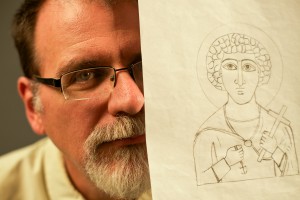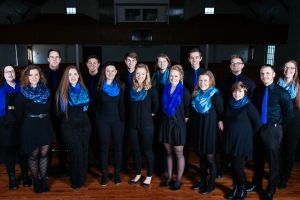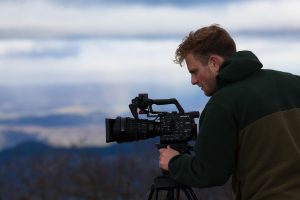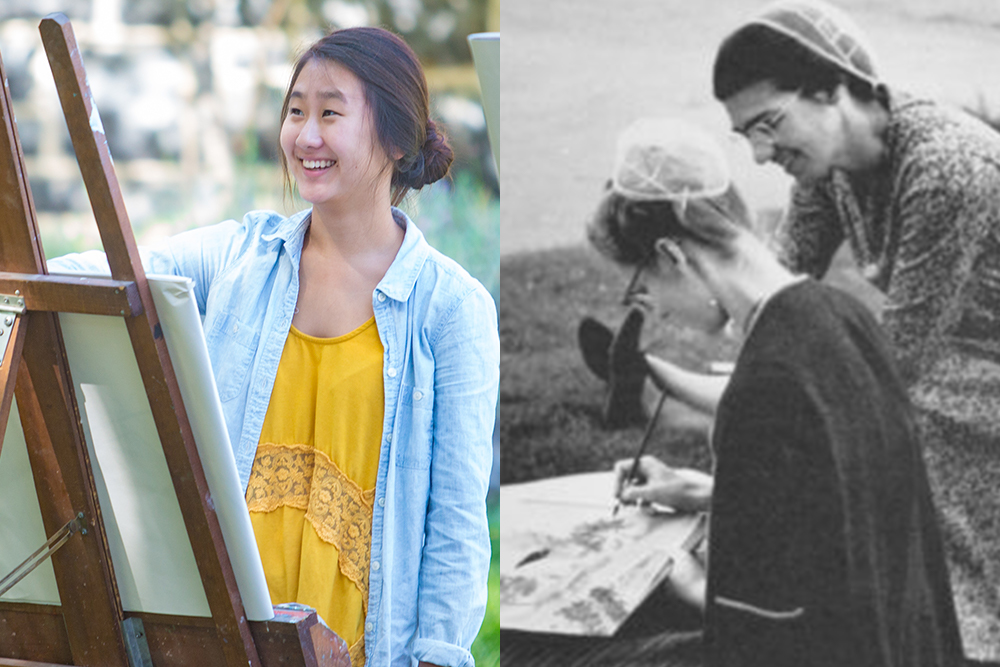Students entering Eastern Mennonite University today may not realize that in their grandparents’ generations, this institution offered one music option: Singing, usually in four-part harmony, a cappella hymns only.
For arts more broadly, until the late 20th century, many North American Mennonites limited the arts to purposes of functionality, as in hand-crafted quilts for beds or pottery to contain foodstuffs, or education, as in artistic creations with explicitly Christian themes.

As early as the 1920s some tentative steps were taken towards permitting visual and performing arts on campus, but that tension was not fully resolved until the 1970s. (This approximation is a venture based on this timeline, but perhaps alumni of that era may provide other evidence to the contrary.)
During mid-1960s through the 1970s – encompassing 15 years of great social change within Eastern Mennonite College and beyond – president and theologian Myron Augsburger BA ’55, BTh ’58, guided the institution from insularity into full acceptance of activities that undergird a liberal arts college, including art, instrumental music, drama and intercollegiate athletics.
Now at EMU, students learn to study and use art transform the world, discover purpose, deepen faith, reach across generations and enter into healing spaces.
This timeline of the arts at Eastern Mennonite was created by Randi B. Hagi ’15 and editor Lauren Jefferson. It was reviewed by professors Jerry Holsopple, John Fast, Joan Griffing, John Horst, Heidi Winters Vogel, Stephen Sachs and Barbra Graber, as well as by Gretchen Maust ’73.
We welcome additions or comments. Please use the comment box at the end of this article.
***
1913
The first constitution specifies that only vocal music was to be taught, and no instruments were permitted.
1918
Noah D. Showalter joins the faculty as the first music teacher. He has a certificate from the American Normal School of Music in Harrisonburg, and had studied voice under renowned teacher J.D. Brunk.
1920
Students form music groups for entertainment: duets, quartets, choruses, trios, octets and double mixed quartets.
1921

Commencement includes music.
1922
The first president, J. B. Smith, resigns because he has a piano in his home, which his oldest daughter plays. (Instrumental music was officially banned from Mennonite churches.) The Smith family returns to Ohio. He was replaced by A.D. Wenger, whose wife Anna May Wenger then gave up her pump organ in support, although she was later chastised for subsequently playing at someone else’s home.
C.K. Lehman directs “The Holy City” at commencement, which becomes an annual performance until 1970.
1923
The first issue of the Eastern Mennonite School Journal is published, as well as the first annual.
1924
A faculty quartet is formed. Seniors were allowed individual photos in the school annual.
1927
Virginia Conference forbids bishops, ministers and deacons from possessing musical instruments and urges all members to do the same. (This is rescinded in 1947).
“Any instrument playing rag-time music had to be deposited with the business manager or sent home,” says the student handbook.
The first visual art classes are taught at the high school level by a home economics teacher.
1930
The “X-Hall” or “Guild,” a small building behind Northlawn Residence Hall, is built as an exercise hall, but is eventually used as a theater and arts studio. It is now a storage space.
More than 70 percent of the student body (148 at the time) belonged to one of three campus choruses, which sang only hymns and only a capella (without instrumental accompaniment).
1937
The Mixed Choir makes the first tour to Johnstown, Pennsylvania.
1939

Mark Stauffer ’35, Juilliard-trained and a Madison College graduate, is the first full-time music instructor and first faculty member with a music degree. He expands offerings beyond the previously offered two courses, to appreciation, voice, introduction to music, history of music, church music, theory and choral conducting. Stauffer will lead choirs through the ’60s.
The Christmas Cantata, first offered by faculty as a gift to students, becomes a tradition.
The Weather Vane newspaper begins as a one-page mimeograph, growing to a two-page pamphlet by its third issue.
1943
Lehman Chapel is built as an all-purpose space for chapel, music and theater, among other activities.
1944
Margaret M. Gehman becomes the first art professor. She also teaches physical education until her retirement in 1987, but then continued teaching a watercolor class until 1996.

Skits are allowed but must be “purposeful rather than merely entertaining.” Costuming is not allowed, but draping (wearing of clothes over regular attire) is.
1945
The Shenandoah annual is established.
1947
A second touring choir is formed by 24 members of the mixed chorus. They visit Ontario churches.
The original farmer’s cottage, located near the current seminary building, is converted to EMC’s first art building.
1948
The faculty council expresses mixed concerns, but not consensus, about student attendance at opera and Shakespeare productions.
Guitars, phonographs and other instruments are allowed to be played in the recreation room in the basement of Northlawn Residence Hall.
Earl M. Maust joins the faculty. He teaches until his death in 1969.
1949
A faculty committee recommends allowing the use of motion pictures for teaching.
1952

The record player for instructional purposes is allowed.
1954
WEMC begins, with singing and spoken broadcasts. No instrumental music recordings are allowed. Read more here.
1955
The faculty adopt a statement about dramatics that limits productions to less than full performances, with costuming and props kept to a minimum.
1956
The Journal and the Weather Vane merge, and the Weather Vane changes to a newspaper format, including halftone photographs.
1958
The Phoenix, EMU’s literary and visual arts journal, is founded by Professor I.B. Horst ’39. Literature professor J. Herbert Martin ’59 serves as its first editor.
1959

Films are shown once a month for entertainment purposes in the assembly room.
1960
The first full-length theater production, sponsored by the Smithsonian literary society, is The Diary of Anne Frank.
A Festival of Fine Arts features plays, lectures on the arts, art displays and musical presentations.
1961
The Windsock, the Eastern Mennonite High School newspaper, separates from the Weather Vane. The first infographics and editorial cartoons are run in the Weather Vane.
1962

A piano is permitted in the music department for “technical studies.”
Instrumental music is no longer banned on college radio broadcasts.
A piano is accepted as an alumni gift for the student lounge.
1963
The Piranha, the first underground student newspaper, forms in the face of administration censorship of the Weather Vane. Censorship was dropped the following year, and the Piranha died with it.
1965
A small student instrumental group forms, which soon grows to an orchestra led by music professor Ira Zook.
1968
The new Suter Science Center opens, and with that, the largest classroom on campus is used as a recital hall, theater, and general performance space.
Faye Garber Yoder graduates as EMC’s first piano concentration under the music major.
1970
“Rebirth,” a student group, releases their first album after first playing together during the 1969 Miracle Fund Drive for the new Hartzler Library. The group eventually went on two tours and in 2016, released a third and final album. Read more here.
The Board of Trustees approves the commission of painted portraits of the five college presidents, to be placed in the new Hartzler Library. This building is dedicated in October 1971, with the portraits, painted by Oliver Schenk, hanging in the second floor “President’s Room.”

1972
Esther Kniss Augsburger graduates as the first art major, earning a degree in secondary art education. The current art building is named after her, and her sculptures can be found around campus, such as the Love Essence white figures by the seminary. She founds the EMHS arts program, which she runs until 1980.
1976
Lehman Chapel is renovated for essentially the first time, becoming EMC’s first performing arts auditorium, with sound equipment, side stage exits, dressing rooms, and a rehearsal hall.
1981
Barbra R. Graber ’76 becomes the first theater professor (specifically, assistant instructor in drama)
1981
The EMU JAZZ, a big band ensemble, and Swing Sisters, a female vocal ensemble, begin under the direction of Professor Stephen Sachs.

1983
“Basileas” forms, an eight-member traveling drama and music group which performs in Michigan, Ohio and Pennsylvania church and schools.
Also in 1983, a cast of eight actors in “Storm: An Improvisation on the Theme of the Sexes” bring in poetry, monologues, sketches and skits, scenes from larger plays, even cartoons that are then woven together into an original show that introduces the larger culture’s discussion of feminist ideas through humor and improvisation. “It was quite an undertaking!” Barbra Graber remembers. “The audiences were enthusiastic. Sociology professor John Eby and his wife pulled me aside after the show to say, ‘We wish we had seen this show about 20 years ago!'”
1985
Bradley Swope graduates as the first organ major.
1986
The Weather Vane switches to desktop computer publishing.
1991
Working with Ted Swartz ’89, M.Div ’92, Professor Barbra Graber ’76 co-founds and directs AKIMBO, an award-winning community-based professional theater with Mennonite themes and participants. The group continues until 1998. Members included Lee Eshleman ’86, Suzanne Kiblinger ’91 Kratz, Jeremy Frey ’92, Pamela Frey ’92, Rose Stauffer ’85, Ingrid DeSanctis ’88, Duane Sider, Nancy Good and Joy McIlvaine ’88.
1992
The Shenandoah Valley Bach Festival, a week-long summer music festival, begins.
AKIMBO is commissioned to create the 75th anniversary theater production. Barbra Graber, Ted Swartz and Duane Sider collaborate in the playwriting.
Also in 1992, “HomecomingHome,” a collaboration of Kenneth J. Nafziger and Barbra Graber, presents dramatic and musical segments “on the theme of coming home to the Body, as sacred temple; to the Earth, where all things are connected; to the Family, with the tragedy of abuse and dysfunction as well as the joy of togetherness; and to Death, our natural place of rest.”
1996
“Drippings of the Honeycomb” is a theatrical multi-media performance based on portions of the Psalms and Proverbs. Barbra Graber says of this production that she may have never experienced “a more profound creative experience. We would begin each rehearsal going into quiet prayer and guided meditation on the chosen Psalm or Proverb. Then we would get up and begin to embody what came to us during the quiet time. It was truly profound. I had the distinct feeling that the text was somehow infusing us with creativity.”
1998
The first digital media classes are taught by Jerry Holsopple, then a part-time instructor.
2000

A communication major is created within the Language and Literature Department, with an emphasis on digital media. (The first full-time faculty member, in 2001, is Jerry Holsopple).
2002
Previously housed under the expansive Language and Literature Department, communication and theater become autonomous departments, moving along with art into the newly renovated University Commons office suite.
2003
Professor Ken J. Nafziger leads the EMU Chamber Singers on a trip to Cuba along with Ysaye Maria Barnwell, a member of the renowned gospel group Sweet Honey in the Rock. From 1999 to 2003, when President Bill Clinton opened the doors to Cuba through education-centered travel permits, Nafziger made 11 music-centered trips.
2004
The jazz band plays its final season.
2006
Digital media and photography majors are added. The Visual and Communication Arts Department, known popularly as VACA, is the result of a merger between the communication department and the art department.
2007
WMRA picks up the WEMC broadcast, retaining Mostly Mennonite, Mostly A Cappella, hosted by emeritus professor John Horst, from 8-9:30 a.m. Sundays (encore at 8 p.m. Wednesdays). Also retained is the Park View Mennonite Church worship services, from 9:30-10:30 a.m. 91.7 FM and online at wemcradio.org.
2008
Theater professor Heidi Winters Vogel and student Pam Mandigo ’08 found CrashHouse Collaborative Theater Project, a summer high school theater workshop. This program is supported by Arts Council of the Valley and EMU with students from area high schools.
2009
Professor Cyndi Gusler introduces trash fashion to EMU. The biannual Mennonite Church convention begins featuring the show.
2009-2010
Renovations in the older part of the University Commons create two new theater spaces, a new digital media lab and the Margaret Martin Gehman Gallery.

2010
Into the Window is the first exhibition in the new Margaret Martin Gehman Gallery, featuring icons painted by Jerry Holsopple during his year in Lithuania as a Fulbright Scholar.
Phase II construction of the University Commons is completed, including the renovated 200-seat MainStage Theater, the relocated Lee Eshleman Studio Theater, the new Margaret Martin Gehman Art Gallery and the new Kenneth A. Longacre Sr. Advanced Media Lab. The facility is dedicated in the spring of 2011.
2011
The Bus Stop by Chinese Nobel Laureate dramatist Gao Xingjian inaugurates the new MainStage Theater. This production was directed by Heidi Winters Vogel and featured original music by Frances Miller.
The new Studio Theater space is dedicated to actor Lee Eshelman ’86, who also worked in the EMU print shop and as a graphic designer.
2011
Theater professor Heidi Winters Vogel co-founds the “Inside Out Playback Theatre” group, which employs a form of improvisational drama based on audience storytelling, after participating in informal Summer Peacebuilding Institute workshops led by Playback Theatre practitioner Ben Rivers.
2013
No Roosters in the Desert by playwright and immigration lawyer Kara Hartzler ’94, directed by Heidi Winters Vogel, is invited to the Mennonite National Convention in Phoenix, Arizona.

Visual and Communication Arts Department merges with the Theater Department.
2015
Emulate, a touring ensemble, forms under the direction of Professor Ryan Keebaugh.
Jonathan Drescher-Lehman ’15 is the first EMU student to win entrance into the prestigious North American Nature Photography Association College Scholars program. He produces a film, with other scholarship recipients and professionals, about the San Diego Bay National Wildlife Refuge.
2016
Professor Justin Poole and his wife, Amanda, lead the first theater-focused cross-cultural semester in Central Europe. The group of 22 students attended 35 plays, visited 38 theaters, and produced their own dramatic piece about the different stages of cultural integration.
Professor Steven David Johnson’s conservation photography course is one of two in the United States highlighted by The International League of Conservation Photographers; the other is taught at Stanford University.

2017
Jazz band revitalized with the help of student saxophonist Harrison Horst ’17 and director Greg Curry.
Macson McGuigan ’17 is the second EMU student to win entrance into the prestigious North American Nature Photography Association College Scholars program. He produces a film, with other scholarship recipients and professionals, about a proposed Florida wildlife corridor.
“Guns into Plowshares,” a 400-ton sculpture by Esther Augsburger ’72 and son Michael ’80, is mounted at EMU after years of display in Washington D.C.
During Homecoming and Family Weekend, Ingrid De Sanctis ‘88 and Ted Swartz ’89, MACL ’92, are joined by alumni actors to debut What we bring. What we take. What we leave.
The 10 x 10 x 100 Centennial Art Show, curated by Ashley Sauder Miller ’03, features six prominent alumni artists and their 100 works measuring 10 inches x 10 inches. A percentage of the sales will be donated to the EMU arts program.

I was fascinated to read that the second choral group traveled to Ontario in 1947. I was a year old and know this story only because I heard it many times. My parents hosted 2 men (A. Don Augsbuger and Warren Rohrer) and 2 women (Lois Hagey Brenneman and ?). A snow storm prevented the choir to leave the area as scheduled. My mother had butter tarts ready for a reunion but the reunion was postponed due to the storm. The 4 EMC’ers were happy to help eat those delicacies. My husband (Rick Umble from PA) and I were married in Ontario in 1974 and located in PA. When my parents (Elmer and Mattie Schwartzentruber) came to visit us they frequently connected with Lois and her husband John. Usually the conversation included the butter tart story!
In the Spring of 1966 the students in the Zelathean Society put on a production of H.M.S. Pinafore, the first musical comedy performed at EMC. As director of the show I had to get permission from President Myron Ausburger to use the big ‘D’ word. He wondered if we couldn’t just substitute another word to replace it. I told him that it was central to one of the themes of the show. So it was used, but not in Lehman auditorium because live piano accompaniment was not allowed on stage. So several sold out shows were performed at Eastern Mennonite High School. We worked hard often rehearsing very early in the morning. What fun!
Faye Garber Yoder ’68